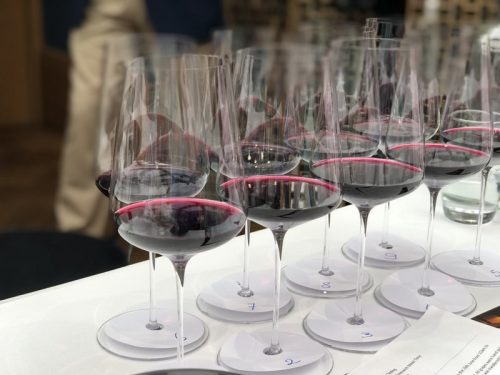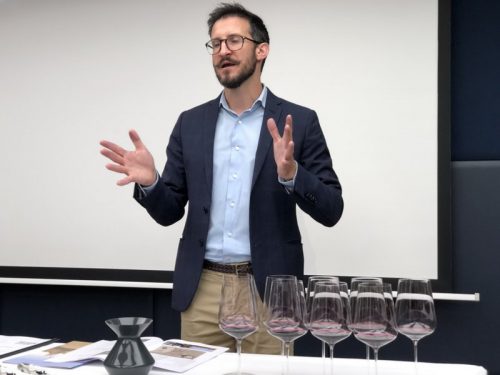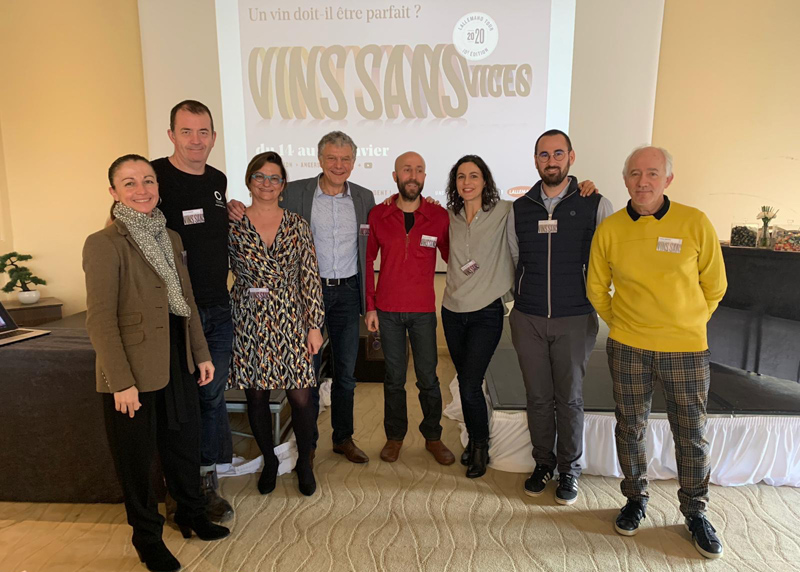
Today, I attended a really interesting tasting looking at the effect of the ageing vessel on a red wine. It was hosted by Domaine Gayda, and titled a nine-vessel tasting.
Of late in the world of wine there has been a lot of interest in alternative elevage. In the past, wineries would traditionally use large concrete tanks or large oak barrels, and more recently small oak has been the favoured choice. But increasingly, winemakers have been experimenting with alternatives.
A Syrah vineyard from the Roussillon was chosen for this experiment. All grapes were hand picked and vinified in stainless steel tanks in the traditional way, then the wine was transferred into nine different vessels.

Tim Ford (Managing Director) and Vincent Chansault (Winemaker, pictured above) led the tasting.
Domaine Gayda is in the western part of the Languedoc near Limoux, and the domaine was founded in 2003, when they began planting their own vineyards. In addition to their own vines, they work with a range of different terroirs in the Languedoc and Roussillon, and buy in lots of grapes. Recently they have been focusing on buying key vineyards in the Roussillon as they become available.
This wine is made from the Col de la Dona vineyard, which is based on pure schist, facing east, 20 km from the sea. This has been a component of Gayda’s top wine, Chemin de Moscou, since 2007, and they recently bought the vineyard. The wine was made from 30 year old Syrah vines. It’s a big block, picked within 3 or 4 days, fermented at the same time. After pressing everything was put together, and so this is exactly the same wine, which was then aged in nine different vessels. This is 2018 vintage, so it will have been in the vessels for around 8 months. It’s 14.6% alcohol, and 45 ppm total SO2 with 25 ppm free SO2. Fermentation was without any sulfites, which were only added after malolactic fermentation had completed. It is one of the components of Chemin de Moscou, which is always aged for two years.
‘This is not a lab experiment,’ says Vincent. One of the nine is a stainless steel tank which is quite neutral. One is a 2000 litre foudres, which they have been using for a few years now. You’d expect less influence. They have used concrete eggs since 2012, when they started farming biodynamically, and using less SO2. There is a sandstone jar, which they started using two years ago. This is quite air tight and there is no movement of the lees at all. Terracotta egg is from Italy, which is fired at a high temperature to be liquid tight but still allowing air exchange. Last year they acquired a plastic egg: the nice thing about this is it has a specific oxygen exchange, which is supposed to match a new oak barrel. Then there is a more traditional 500 litre barrel with light toast from Boutes. And 228 litre barrels: one is one year old and one three years old.
We did the tasting blind (we were given the choice to taste) and these are my notes as written.
- One year old oak barrel, 500 litres (27 mm stave thickness, lightly toasted, Boutes Grande Reserve)
Sweetly aromatic nose is a little jammy with ripe, alluring black fruits. The palate is fresh with nice grainy structure, a bit of grip, and very sweet, pure fruit. Quite a fresh expression. Nice structure here. 91/100 - Sandstone jar, 1000 litres (fired between 1100 and 1350 C, with low porosity)
This has rich, intense, sweet black fruits but there’s some integration to the structure on the palate. Lovely purity to the fruit, and nicely structured. 92/100 - Three year old oak barrel, 228 litres (27 mm stave thickness, Sylvain Grande Reserve)
Smooth and harmonious with nice grainy structure under the sweet fruit. The richness is reined in a little, and it has a bit more seriousness. 93/100 - Concrete egg, 1600 litres
Very floral on the nose, this is a pretty expression of the wine, with sweet, silky, slightly jammy fruit. It’s really fresh and vivid, pushing the aromatics and fruit to the fore. 91/100 - One year old oak barrel, 228 litres (27 mm stave thickness, Sylvain Grande Reserve)
Brooding and less overt on the nose, this shows compact, structured fruit on the palate. There’s freshness and purity here, but also more textural interest. Grippy and tannic, but the tannins are quite harmonious. 94/100 - Stainless steel tank, 1500 litres
Rich, ripe, structured and quite chocolatey. A big, burly, classically styled expression of this wine that’s a little more international. A blockbuster with lots of sweet fruit, some spice, and structure. 92/100 - High density polyethylene egg, 1000 litres (17 mg/l per year oxygen transmission)
Sweet, ripe and lush with silky berry fruits. Quite jammy and rich with a distinctive sweetness to the fruit. Polished and pretty. A crowd pleaser. 91/100 - Terracotta egg, 700 litres (fired between 900 and 1050 C, to give high porosity)
Lush, ripe and sweetly fruited with plush berry fruits, but also some nice grainy structure. Has nice density and weight with some grip alongside the lush fruit. 92/100 - Oak foudre, 2000 litres
Some slight hints of oxidation here, although they are slight. This has the plushest, most lush expression of all the wines, with soft, sweet, slightly jammy fruit. Very smoothly structured on the palate with refined tannins. I’m not sure about this: I love the texture, but it seems a little prematurely developed. 90/100
So, what are my conclusions? First, there were clearly differences between these wines at an early stage. But they weren’t always the differences I would have expected in theory, necessarily. It’s worth noting, though, that this is a very ripe expression of Syrah, weighing in at 14.6% alcohol, so some of these results may be particular to this sort of wine. With a wine that’s lighter or tighter, with less exuberant fruitiness, then the results might be different. Basically, having all these different vessels is like having a range of cooking pots: a good chef will use them for different purposes, and different wines will respond differently to different ageing regimes. Good on Gayda for putting on this really interesting tasting.
4 Comments on Domaine Gayda’s Nine Vessel Tasting


Be interesting to know the fill levels. Am I right in thinking surface area (direct exposure to oxygen) will play a significant part? Could that be why the 2000 l. foudres’ wine is more developed?
Thanks! Good Stuff…
Scores run 90-94 points, so no appreciable difference. If the tasting is replicated blind again, perhaps that would further muddy the waters. A profession taster could probably consistently differentiate a couple of the wines in a blind setting after repetition. Less than 5% difference on a 100 point scale, but consider the margin of error. For the general public, it probably doesn’t matter. Interesting topic though, and I am amused that the non-trendy 228L did so well. Thank you for your notes!
Worth repeating in 2 years and then some years later to have comparative impressions of post bottling development?